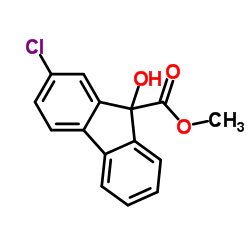Chlorflurenol-methyl in soil: degradation, leaching, and effects on microbiological processes.
D Eichler, W Heupt, J P Anderson, K H Domsch, G Jagnow
Index: Arch. Environ. Contam. Toxicol. 11(2) , 185-93, (1982)
Full Text: HTML
Abstract
Tests were conducted with the synthetic growth regulator chlorflurenol-methyl to investigate its rate of degradation in soil, leaching behavior, and possible side-effects on the soil microflora and on soil physiological processes. With two sandy soils (Ct = 1.0 and 2.58%) which were treated with 11.35 mg kg-1 chlorflurenol-methyl (congruent to 2.8 kg a.i. ha-1), over 90% of the compound disappeared within 4 to 8 days. The degradation products were 2-chloro-9-hydroxyfluorene-9-carboxylic acid and 2-chlorofluorenone, which undergo further decomposition. In leaching tests with three sandy soils (Ct = 0.69, 1.0 and 2.58%), chlorflurenol-methyl was not washed from the soil; however, with one soil (0.69% C), very small residues were observed in the effluent identified as 2-chlorofluorenone. In side-effects experiments with a parabrown (Ct = 1.26%) and a chernozem soil (Ct = 2.3%), which were treated with 1 and 10 mg kg-1 chlorflurenolmethyl, no persistent inhibition of anaerobic or aerobic nitrogen fixation (C2H2-reduction) was detected. Ammonification, nitrification, and mineralization of soluble starch were also not influenced. The mineralization of cellulose in compost soil (Ct = 13.59%) was temporarily delayed; however, this delay was later compensated for by a higher mineralization rate. The colonization density of fungi on soil particles and the numbers of bacteria, actinomycetes, and fungi were not negatively influenced. Chlorflurenol-methyl does not significantly influence these microbiological processes and populations in the soil.
Related Compounds
| Structure | Name/CAS No. | Molecular Formula | Articles |
|---|---|---|---|
 |
chlorflurenol-methyl
CAS:2536-31-4 |
C15H11ClO3 |
|
Indole acetic acid distribution coincides with vascular diff...
2002-09-01 [Plant Physiol. 130(1) , 199-209, (2002)] |
|
Auxin is required for leaf vein pattern in Arabidopsis.
1999-12-01 [Plant Physiol. 121(4) , 1179-90, (1999)] |
|
Responses of plant vascular systems to auxin transport inhib...
1999-07-01 [Development 126(13) , 2979-91, (1999)] |
|
Nicotine synthesis in Nicotiana tabacum L. induced by mechan...
2006-01-01 [J. Exp. Bot. 57(11) , 2899-907, (2006)] |
|
Effect of auxin transport inhibitors and ethylene on the woo...
2004-01-01 [Plant Biol. (Stuttg.) 6(1) , 22-9, (2004)] |